
Toxic mold doesn’t just impact humans. Nope. House pets can suffer from a wide variety of health issues due to exposure to mold and mycotoxins.
As many of you reading this post might know, I walked away from everything I owned after my toxic mold nightmare. Everything except my car and my pets (cats and a house rabbit).
Some people were shocked that I kept my pets. They assumed that it was impossible to remove mold spores from animal fur. It never occurred to me to euthanize or rehome my pets – they are family members after all. Instead, I researched how to safely and effectively “remediate” my pets.
A little further along in this post I will discuss exactly what I did to remove mold spores from animal fur making my pets safe to cohabitate with again. But before we get to that, I need to share a little something that most people don’t think about when it comes to mold and pets.
Mold spores in animal fur aren’t exclusive to a mold exposure from the home they are living in.
Nope. In fact, house pets can and often do carry various molds on their body and they release these molds into their indoor environments. In fact, pet hair and dead skin flakes (dander) are a great source of nutrition for mold.
Scary right? Here you are practicing mold prevention and your dog or cat is exposing you to mold daily.
Research shows that both cats and dogs often carry various toxic molds and mycotoxins in their hair with some studies finding molds in 100% of cat hair and 80% of dog hair. If you have dog or cat allergies, this could be the smoking gun as to why!
The science of household pets carrying molds on their fur.
In a 1996 study of stray cats in Iran, researchers examined the fungal flora of the hair coat of 100 stray cats in different districts of the city of Isfahan, Iran, were examined. Saprophytic fungi were isolated from all cats. Meaning 100% of the cats tested positive for various molds in their hair and skin. Penicillium, Aspergillus, Alternaria, Mucor and Cladosporium spp. were the most frequently isolated saprophytes. (1)
The fungal flora of the coat of 172 healthy pet cats was examined qualitatively in a 1991 study. Fungi were isolated from 136 (79%) of the 172 cats. Fifteen genera were isolated; 13 are commonly regarded as saprophytes, and 2 (Microsporum and Trichophyton) are commonly regarded as pathogens. Aspergillus, Alternaria, Penicillium, and Cladosporium spp were the most frequently isolated saprophytes. Dermatophytic fungi, including Microsporum gypseum (n = 1), M vanbreuseghemii (n = 1), and Trichophyton rubrum (n = 14), were recovered from 16 cats. Microsporum canis was not isolated from any cat during this study. (2)
Researchers in a 1996 study examined 944 dogs from Barcelona during a one year period to detect the fungal biota of the fur of dogs. They identified various molds/fungi in approximately 80% of the dog’s hair and skin. Species of Penicillium (% prevalence=89.5%), Alternaria (86.6%), Cladosporium (84.9%), Aspergillus (77.3%), Scopulariopsis (65.7%) and Chrysosporium (64.5%) were the most prevalent.
In 2007, researchers from Korea analyzed pet dogs as a source of providing molds at houses. They performed fungal isolation was performed to the skin and hairs of 70 pet dogs at different houses and veterinary hospitals. A total of 44 fungal isolates were obtained from skin (27 isolates) and hairs (17 isolates) of the dogs investigated for the growth ability of 44 isolates at 37℃, 45% of the isolates were able to grow.
The researchers demonstrated in Korea that pet dogs carry diverse molds commonly present in indoor air. These results indicate that pet dogs can be served as a contamination source of generating fungal bioaerosol into indoor environment having a potentiality of affecting on human health.(3)
It is not just cats and dogs that carry mold spores in their fur. Horses and other animals have been found to be carriers of various molds.
For example, a 1998 study, researchers examined the fungal flora of the hair and underlying skin from 20 horses free of skin or ocular disease. Fungi were isolated from both the hair and the underlying skin of all 20 horses. Twenty-two genera regarded commonly as saprophytes were identified and an additional 2 fungi resembled the perfect state of the cutaneous pathogenic genera Microsporum and Trichophyton. Cladosporium spp, Penicillium spp, and Rhizopus spp were the most frequently isolated saprophytes. In general, similar fungi were isolated from the hair and underlying skin, and differences were not noted in isolates from the saddle and rump regions.(4)
Scary huh?
Before we get to how to remove mold spores from animal fur, let’s look at a few ways to prevent mold on fur in the first place.
If you have a cat or cats, keep them indoors. This eliminates them attracting mold spores from the world outdoors. I know some people just don’t believe in confining a cat to the indoors however, this is the best way to prevent mold spores in cat fur.
If you prefer to allow your cat outdoors, consider making them an outdoor cat with privileges to one indoor space like a garage or mudroom. This reduces the possibility of your cat dropping mold spores throughout your home.
If you decide that an indoor/outdoor cat is the only way to go, you will at the very least brush your cat’s fur before allowing it inside. Wiping your cat’s fur with a damp cloth is advised as well.
If you have a dog, it is more difficult to avoid mold transfer from fur to house. My best advice is to wipe your dog’s paws before they come inside and brush them quickly before they enter the house.
For all animals going outside and coming back inside, be sure to keep their nails trimmed which prevents some transfer of mold spores. Brush your pets daily and bathe (see below) regularly. In addition, wash pet bedding weekly with EC3 laundry additive. It removes mold and mycotoxins better than any product out there and has been lab tested to prove it.
Back to the business of removing mold spores from animal fur…
You know your pet has been exposed to toxic mold and mycotoxins and you want to continue safely living with them. You don’t want to cross contaminate your new residence but are unsure how to remove mold spores from animal fur. No worries! I went through this and worked closely with one of the nation’s leading toxicologists (Dr. Jack Thrasher) to figure out how to safely remediate my pets.
I remember Dr. Thrasher giving me a sound piece of advice when it comes to navigating what to do with a house pet who was exposed to mold. He said “You have hair on your head and body right? We aren’t euthanizing you because of it are we? Just like you can clean your body, you can clean your pet. Yes, you can remove mold spores from animal fur.”
Sage advice people. I simply washed my hair and body with a detox soap and called it good. So why wouldn’t I save my pets?
A step-by-step guide on how to remove mold spores from animal fur
Step 1. For dogs and cats, you will want to get them shaved as completely as possible.
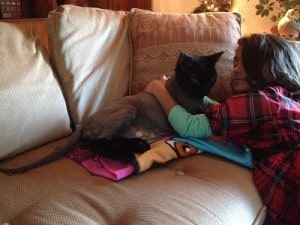
The reason you want to shave your dog or cat is obvious I would think. Why take a chance with contaminated fur? If you know your pet has been exposed to high levels of mold and mycotoxins, it is better to be safe than sorry. Your pet will forgive you.
If you have a house rabbit or other small furry animal, do not shave them. It isn’t safe for them.
Step 2: A Bath With Ammonia
I am not at all a fan of using ammonia for mold. I much prefer this mold solution. However, it is not safe to bathe a pet with.
Pets can safely be bathed in ammonia baths. Measurement ratios for pet detox baths are one teaspoon of ammonia for each gallon of “NON chlorinated” water. DO NOT MIX CHLORINATED WATER WITH AMMONIA.
The reason for using ammonia is that ammonia kills both the mold spores as well as neutralizes the mycotoxin secondary metabolite that is so toxic to animals and humans. It isn’t as effective as that mold solution I love but it comes fairly close. Giving your pet an ammonia bath is completely safe and not toxic if you are using regular household ammonia. It is highly recommended by (Dr. William Croft, DVM, PHD – mold/mycotoxin expert).
Make sure to cover your pet’s eyes and nose when bathing them in ammonia. You may need a second person to help you.
*Important note from me! I did NOT bathe my rabbit in ammonia. I trusted it for my cat but small animals are more sensitive. I would check with your vet before bathing a small animal in ammonia. Instead, I skipped to step 3 for my rabbit.*
Pets can also be safely bathed in baking soda and water but baking soda ONLY kills mold spores but DOES NOT neutralize the mycotoxins left behind on their fur. This is important to know because the mycotoxins are what are dangerous. Also do not let cats ingest the baking soda as it can be harmful to their pH levels. (5) You can buy bulk Baking Soda HERE
Step 3: After the ammonia bath, give your pet a detox bath with an antifungal shampoo.
I highly suggest using a natural clay-based antifungal shampoo to remove mold spores from animal fur. My favorite trusted shampoo is MOOSH. It’s a great natural and pure product that is safe for all animals and is very effective as an anti-bacterial and antifungal wash that also adds additional support using clays that bind to toxins and pull them away from your pet. You can buy MOOSH HERE.
You will want to shampoo your pet at least 3 times initially. Normal maintenance baths only require one shampooing.
While it might be tempting – do not use essential oils to remove mold spores from pet fur. First, there is a lot of debate about whether or not essential oils remove mold. Second, essential oils can be life saving to humans but potentially life threatening to pets.
Step 4: Start using a safe and effective binding agent to detox and pull out the mold and impurities from your pet’s bodies.
Zetox helps remove mold toxins, chemical toxins and heavy metals that build up in your pets body, as well as enhancing general immune function. This Liquid Zeolite formula is the highest potency of Zeolite per serving than in any other Liquid Zeolite product on the market. One serving helps deliver 50% of the necessary daily value of Vitamin D-3.
Dosage ~ Mix the drops in three ounces of water away from food. How much to take depends on your pets weight and health condition. You can start with one drop two times per day and increase from there. Speak to your veterinarian for exact dosages. Generally for a healthy pet, the dosing is as follows:
Cats: 1 to 2 drops for under 10lbs / 2 to 3 drops 11lbs & up twice per day
Dogs: 1 to 2 drops for under 10lbs / 2 to 3 drops for 11-20lbs; 4-5 drops for 21-30lbs; 5-7 drop for 31-49lbs; over 50lbs approximately 8 or 9 drops; over 100lbs one dropper full, twice a day
This product is made for human and animal consumption and is considered safe for animals and pets for everyday detox consumption. Ingredients include a proprietary blend of 100% all natural coconut and berry blend which are considered safe food ingredients. If your pet has any type of berry or coconut allergies avoid this product.
What do you do if you have a fish, reptile, amphibian, or bird.
That’s a tough one. Fish – well – they don’t really carry mold spores so a new tank and accessories is about all you can do. The same goes for reptiles and amphibians. For water loving reptiles and amphibians, you can give them a gentle scrubbing in a shallow tub of water if they will tolerate it.
Birds are a little more complicated. Dr. Thrasher told me he would likely suggest not keeping the bird. However, in my research, I have discovered that treating a bird with the “bird mite” protocol might works for mold spores too.
That’s all I’ve got! I hope you find this post helpful in your quest to remove mold spores from animal fur. If you have any questions, give me a shout!
If you prefer to watch me yabber on about all of this and more, click below to watch my video!
SOURCES:
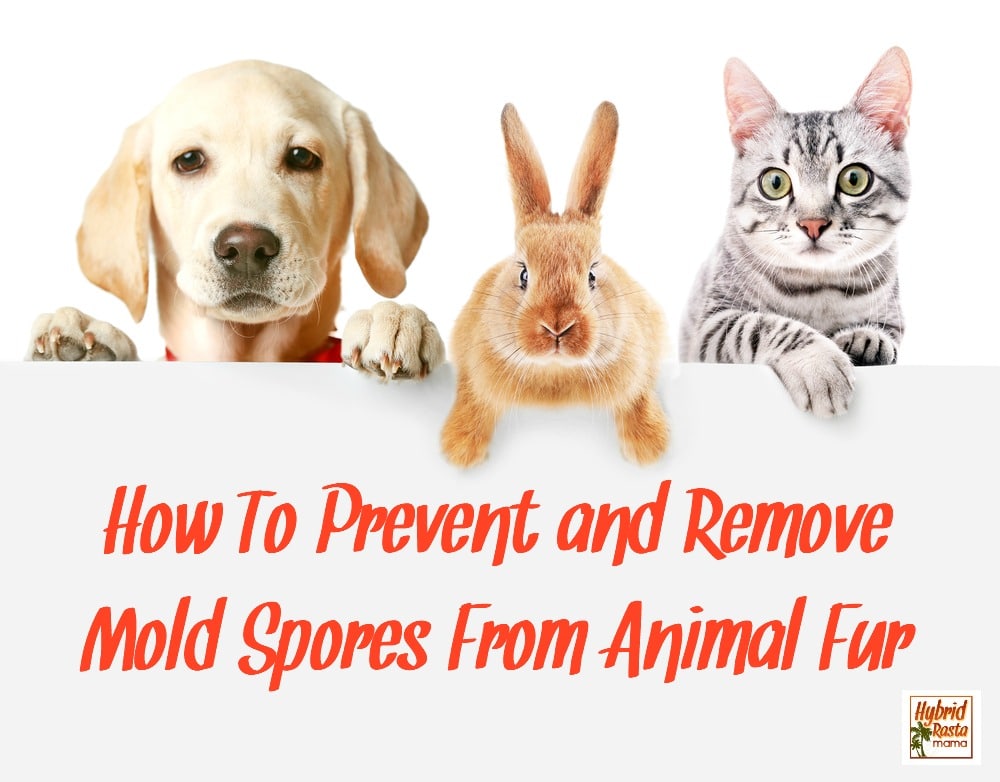

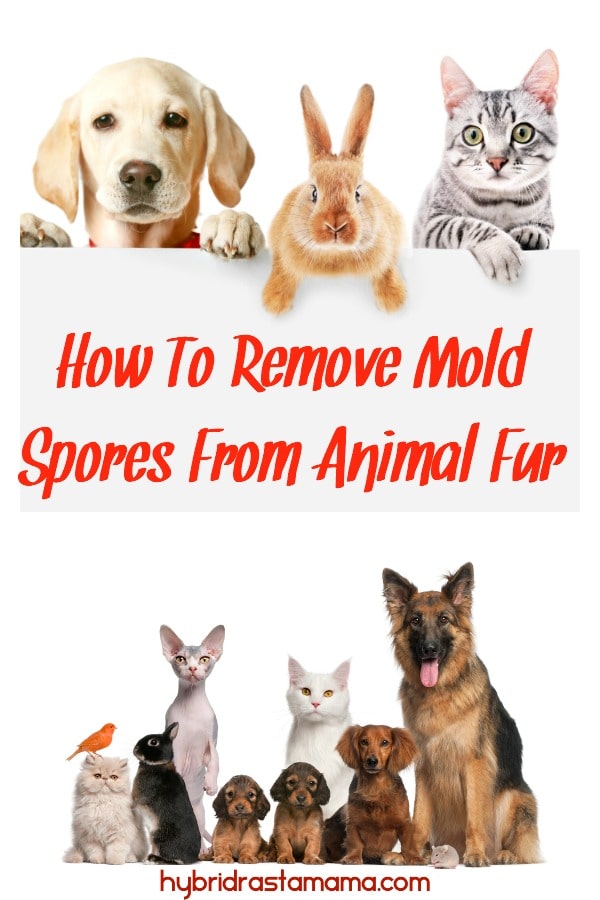



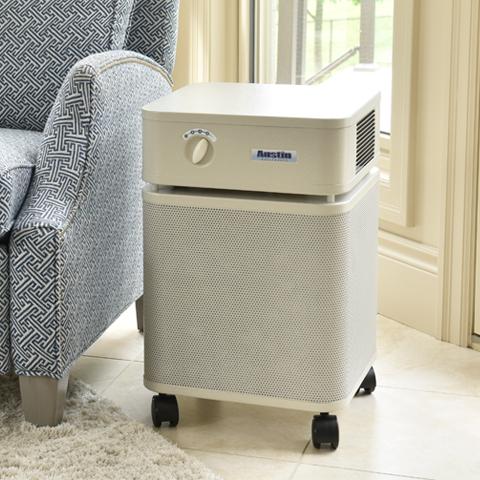

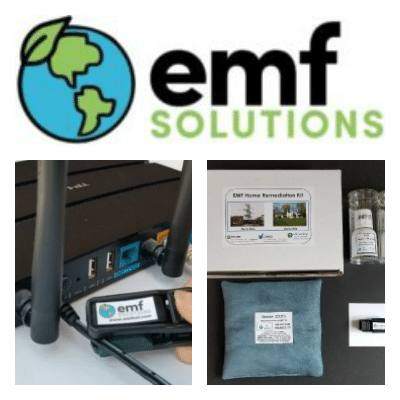


Daniela says
This is a super helpful post for all of us pet lovers out there! Really good tips and solutions – thank you!
Megan Stevens says
Wow, terrific and helpful post; thank you! I like that the vet/groomer can help with shaving the animal, and then the rest can be done at home. I so appreciate all your tips and insights.
Lindsey Dietz says
I wouldn’t have been able to get rid of my pets either, so GO YOU! These are great tips! Pinning to my animals board just in case we ever need to get mold spores out of our pet’s fur!
Shelby @Fitasamamabear says
So helpful! I didn’t realize this was such an issue!
linda spiker says
Oh goodness. I didn’t even know this was a thing! Definitely sending to my allergy prone, dog loving daughter!
Jessica Levinson says
Very informative post! Thanks for sharing your knowledge about removing mold spores from animal fur. Our pets are family and must be cared for in situations like this.
Melissa says
I was very happy find your informative article and immediately ordered all the products you suggested but quickly realized that moosh is not recommended and is dangerous for cats. Is there something that works for cats?
Jennifer says
This is NOT a natural shampoo which I prefer but it is what the vet’s would use: https://amzn.to/2Vp8VwZ
This one is natural but not quite as strong so you would want to use more of it: https://amzn.to/2s8knQb
Hope this helps!
Melissa says
Do you know of a shampoo that works for cats? There are ingredients that are bad for cats.
Erin says
Shaving a mold/mycotoxin-infested pet is NOT A GOOD THING. We already know that mold that is disturbed releases spores and mycotoxins. Shaving an infested animal is going to release those spores/mycotoxins to potentially dangerous levels. I think we need to question that.
Also I’d like to know if there has been any studies that 1tsp of ammonia in a gallon of water is truly efficacious in denaturing and destroying all mold/mycotoxins on a pet? I can’t find any references online.
Jennifer says
Hi Erin! Thanks for the comment and question. If you are shaving a pet you aren’t doing that inside your home I would hope so if spores are released they won’t be released inside your home. I had an extensive conversation with the late Dr. Jack Thrasher, a leading toxicologist specializing in mold and mycotoxins, and he steered me in the direction of shaving a pet and then giving it an antifungal bath. It worked for me personally as I never reacted to any of my pets. I did not shave my rabbit but I also had only had her in that house for a few days as she was a new pet. I do know people who did not shave their pets and did react to them. Once they shaved them, they stopped reacting.
Also, an animal isn’t going to be infested with mold per say. I have never heard of a case where an animal had an active colony of mold growing. It is very difficult to ascertain whether or not a pet would have active or dormant mold spores on it’s fur as well. Yes, in either case mycotoxins could be released but Dr. Thrasher seemed confident that it more likely a person would react to fur than to the act of shaving the animal.
I have a link to an interview with Dr. Croft, DVM regarding ammonia and mold in this post: https://moldhelpforyou.com/does-ammonia-kill-mold/. I consulted with three different vets regarding ammonia and they agreed that 1 teaspoon per gallon was the only safe amount to use on an animal. Does that dilution destroy all mold and mycotoxins on a pet? Probably not. But there is no product out there that does. Having said that, I am currently researching this product extensively: https://www.citrisafe.com/product/remedy-pet-shampoo-16-oz/?wpam_id=65. My talks with the company have been full of great information and I am optimistic that this is an alternative to ammonia that works more effectively. I will be updating this post with more information once I finish my researching and testing of this product.
Alyssa R says
Hello! Your website has been very helpful and informative. I did have a question, you mentioned a detox soap that you used on your hair and body, but the link to the detox soap is not working. Could you repost the link? I’m unable to find any detox soap for humans that could be used for mold spores and mycotoxins, I’ve already ordered Moosh for my dog, and I believed I have fixed his fur with doing the ammonia baths and the Moosh baths. But now I’m trying to figure if mine and my fiances hair could be continuing to make us sick.
Jennifer says
Hi there! They actually stopped making that soap. Thank you for the reminder to update the article! This is what I have been using for the past year and am LOVING it! It actually works a lot better in my opinion. https://www.citrisafe.com/product/remedy-shampoo-body-wash-16-oz/?wpam_id=65 You will love it!